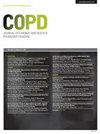呼气静脉量和动脉扭曲度与慢性阻塞性肺病患者的疾病严重程度和死亡风险有关:COSYCONET 的研究结果
IF 3.1
3区 医学
Q1 Medicine
International Journal of Chronic Obstructive Pulmonary Disease
Pub Date : 2024-07-01
DOI:10.2147/copd.s458905
引用次数: 0
摘要
目的:本研究旨在评估计算机断层扫描(CT)定量肺血管形态与慢性阻塞性肺病(COPD)患者的肺功能、疾病严重程度和死亡风险之间的关联:参加全国性前瞻性 COSYCONET 队列研究并进行吸气-呼气 CT 配对的患者。内部开发的全自动软件对肺动脉和静脉血管进行了分割,并对吸气和呼气扫描的体积和迂曲程度进行了量化。通过线性、Logistic 或 Cox 比例危险回归分析了肺血管体积归一化和迂曲度与肺功能(1 秒用力呼气容积 [FEV1])、空气截留(残余容积与总肺活量比 [RV/TLC])、一氧化碳转移因子(TLCO)、全球慢性阻塞性肺病倡议(GOLD)D 组疾病严重程度以及死亡率之间的关系:138 名患者(39% 为女性,平均年龄为 65 岁)提供了完整的数据。FEV1、RV/TLC 和 TLCO(均为预测百分比)与呼气血管特征(主要是静脉容积和动脉迂曲度)显著相关(各为 0.05)。与吸气血管特征的关系不存在或可以忽略不计。GOLD D 和死亡率与血管特征的关系模式相似。除 FEV1 外,呼气静脉容积也是预测死亡率的一个独立因素:结论:通过在慢性阻塞性肺病患者中使用自动软件,可以从呼气 CT 扫描(尽管不是吸气扫描)中提取与临床相关的肺血管信息;尤其是呼气肺静脉容积可预测死亡率:NCT01245933.Keywords:慢性阻塞性肺病 计算机断层扫描 肺血管 血管容积 血管迂曲 肺功能本文章由计算机程序翻译,如有差异,请以英文原文为准。
Expiratory Venous Volume and Arterial Tortuosity are Associated with Disease Severity and Mortality Risk in Patients with COPD: Results from COSYCONET
Purpose: The aim of this study was to evaluate the association between computed tomography (CT) quantitative pulmonary vessel morphology and lung function, disease severity, and mortality risk in patients with chronic obstructive pulmonary disease (COPD).
Patients and Methods: Participants of the prospective nationwide COSYCONET cohort study with paired inspiratory-expiratory CT were included. Fully automatic software, developed in-house, segmented arterial and venous pulmonary vessels and quantified volume and tortuosity on inspiratory and expiratory scans. The association between vessel volume normalised to lung volume and tortuosity versus lung function (forced expiratory volume in 1 sec [FEV1]), air trapping (residual volume to total lung capacity ratio [RV/TLC]), transfer factor for carbon monoxide (TLCO), disease severity in terms of Global Initiative for Chronic Obstructive Lung Disease (GOLD) group D, and mortality were analysed by linear, logistic or Cox proportional hazard regression.
Results: Complete data were available from 138 patients (39% female, mean age 65 years). FEV1, RV/TLC and TLCO, all as % predicted, were significantly (p < 0.05 each) associated with expiratory vessel characteristics, predominantly venous volume and arterial tortuosity. Associations with inspiratory vessel characteristics were absent or negligible. The patterns were similar for relationships between GOLD D and mortality with vessel characteristics. Expiratory venous volume was an independent predictor of mortality, in addition to FEV1.
Conclusion: By using automated software in patients with COPD, clinically relevant information on pulmonary vasculature can be extracted from expiratory CT scans (although not inspiratory scans); in particular, expiratory pulmonary venous volume predicted mortality.
Trial Registration: NCT01245933.
Keywords: COPD, computed tomography, pulmonary vasculature, vessel volume, vessel tortuosity, lung function
Patients and Methods: Participants of the prospective nationwide COSYCONET cohort study with paired inspiratory-expiratory CT were included. Fully automatic software, developed in-house, segmented arterial and venous pulmonary vessels and quantified volume and tortuosity on inspiratory and expiratory scans. The association between vessel volume normalised to lung volume and tortuosity versus lung function (forced expiratory volume in 1 sec [FEV1]), air trapping (residual volume to total lung capacity ratio [RV/TLC]), transfer factor for carbon monoxide (TLCO), disease severity in terms of Global Initiative for Chronic Obstructive Lung Disease (GOLD) group D, and mortality were analysed by linear, logistic or Cox proportional hazard regression.
Results: Complete data were available from 138 patients (39% female, mean age 65 years). FEV1, RV/TLC and TLCO, all as % predicted, were significantly (p < 0.05 each) associated with expiratory vessel characteristics, predominantly venous volume and arterial tortuosity. Associations with inspiratory vessel characteristics were absent or negligible. The patterns were similar for relationships between GOLD D and mortality with vessel characteristics. Expiratory venous volume was an independent predictor of mortality, in addition to FEV1.
Conclusion: By using automated software in patients with COPD, clinically relevant information on pulmonary vasculature can be extracted from expiratory CT scans (although not inspiratory scans); in particular, expiratory pulmonary venous volume predicted mortality.
Trial Registration: NCT01245933.
Keywords: COPD, computed tomography, pulmonary vasculature, vessel volume, vessel tortuosity, lung function
求助全文
通过发布文献求助,成功后即可免费获取论文全文。
去求助
来源期刊

International Journal of Chronic Obstructive Pulmonary Disease
RESPIRATORY SYSTEM-
CiteScore
5.10
自引率
10.70%
发文量
372
审稿时长
16 weeks
期刊介绍:
An international, peer-reviewed journal of therapeutics and pharmacology focusing on concise rapid reporting of clinical studies and reviews in COPD. Special focus will be given to the pathophysiological processes underlying the disease, intervention programs, patient focused education, and self management protocols. This journal is directed at specialists and healthcare professionals
 求助内容:
求助内容: 应助结果提醒方式:
应助结果提醒方式:


